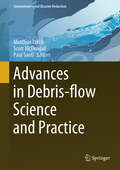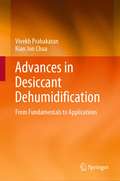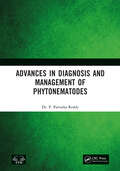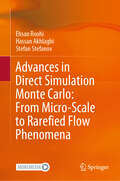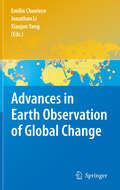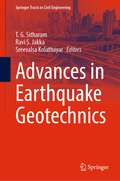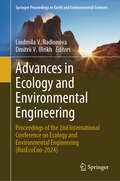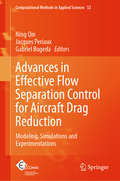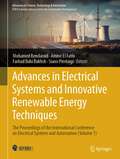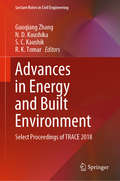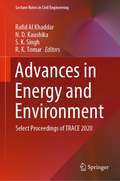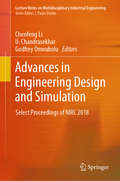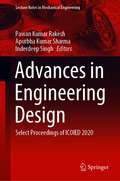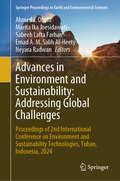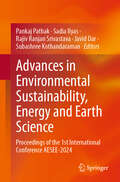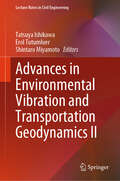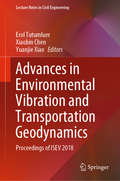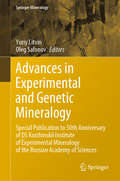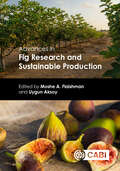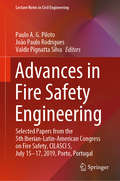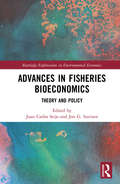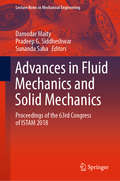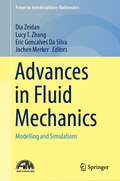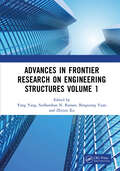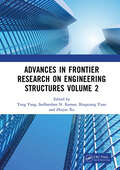- Table View
- List View
Advances in Debris-flow Science and Practice (Geoenvironmental Disaster Reduction)
by Matthias Jakob Scott McDougall Paul SantiThis book provides a summary of the state of the art of all facets of debris-flow science and practice and is designed to be a comprehensive technical reference for practitioners and a state-of-the-art research overview for scientists. It is richly illustrated with equations, graphs, photos, and tables. The book allows students, practitioners, and regulators to get a sense of the current state of the art in this science. Currently, there are 2 to 3 papers published every week on some aspects of debris-flow science. This creates a bewildering amount of literature that cannot be captured by a single individual. This book provides a comprehensive overview of all facets to date, including initial hazard assessments, detailed quantitative risk assessments, debris-flow warning systems, debris-flow mitigation structure designs, and failures of mitigation works, as well as new topics such as climate change effects on debris flows.
Advances in Desiccant Dehumidification: From Fundamentals to Applications
by Vivekh Prabakaran Kian Jon ChuaThis book systematically analyses state-of-the-art technology and research related to desiccant dehumidification. It provides key insights into the current research direction, and presents global research and development interests. It begins by offering a comprehensive review of conventional desiccants and their underlying engineering challenges. Fundamental material characteristic properties and factors critical to the desiccant synthesis are highlighted.The applicability of next-generation advanced materials to address the challenges is documented, and the advantages of desiccant coated heat exchangers are evaluated. Lastly, the potential applications of desiccant dehumidifiers in various energy-connected applications are discussed, and case studies on industrial/building cooling systems are provided. Specifically targeted at HVAC engineers, thermal scientists, energy-engineering researchers, and graduate-level students in the field, the technical content balances fundamental concepts and applications.
Advances in Diagnosis and Management of Phytonematodes
by P. Parvatha ReddyAdvances in Diagnosis and Management of Phytonematodes provides information on various aspects of diagnosis and eco-friendly nematode management. It explains at length nematode diagnosis—morphological, biochemical and molecular—and management strategies—regulatory, physical, cultural, chemical, biological, host resistance and integrated management methods. This book will be of immense value to the scientific community involved in teaching, research and extension activities related to the diagnosis and management of phytonematodes. It is suitable for teaching both undergraduate and postgraduate courses in the field of plant protection. It can also serve as an advantageous reference to policymakers and practicing farmers. Print edition not for sale in India.
Advances in Direct Simulation Monte Carlo: From Micro-Scale to Rarefied Flow Phenomena
by Ehsan Roohi Hassan Akhlaghi Stefan StefanovThis book provides a comprehensive and in-depth presentation of recent advancements in the Direct Simulation Monte Carlo (DSMC) method, focusing on modern collision algorithms that maintain accuracy even with low particle-per-cell. Drawing from theoretical insights and computational innovations, it bridges fundamental kinetic theory with practical simulation techniques for rarefied gas flows. Structured across ten chapters, the book begins with a discussion of micro- and nanoscale fluid flows, where non-equilibrium effects and rarefaction become dominant. It explores key phenomena in MEMS/NEMS devices, such as velocity slip, temperature jump, Knudsen minimum, and thermal polarization—essential for understanding transport in confined geometries. A strong emphasis is placed on advanced DSMC collision schemes, including the BT-family of algorithms (e.g., SBT, ISBT, GBT, SSBT, and SGBT), as well as emerging hybrid approaches such as DSMC-Fokker-Planck and Low-Variance DSMC. Applications span from pressure-driven microchannel flows, thermally induced rarefied flows, and Couette/cavity configurations, to supersonic wedge flows and nonlinear instability phenomena like Rayleigh–Bénard convection in rarefied gases. Special attention is given to semi-analytical aerodynamic models in free-molecular regimes, making the book particularly valuable for those working in aerospace applications at high altitudes or in low-density environments. With contributions from leading experts, this expanded volume serves as both a reference and a teaching guide for researchers and students in rarefied gas dynamics, microfluidics, and high-fidelity particle-based simulation methods.
Advances in Earth Observation of Global Change
by Emilio Chuvieco Xiaojun Yang Jonathan LiGlobal Change studies are increasingly being considered a vital source of information to understand the Earth Environment, in particular in the framework of human-induced climate change and land use transformation. Satellite Earth Observing systems provide a unique tool to monitor those changes. While the range of applications and innovative techniques is constantly increasing, this book provides a summary of key case studies where satellite data offer critical information to understand the causes and effects of those environmental changes, minimizing their negative impacts. This book will be of interest to researchers and practitioners in the field of remote sensing, geographical information, meteorology and environmental sciences. Also scientists and graduate up to post-graduate level students in environmental science will find valuable information in this book.
Advances in Earthquake Geotechnics (Springer Tracts in Civil Engineering)
by T. G. Sitharam Sreevalsa Kolathayar Ravi S. JakkaThis book brings together contributions from world renowned researchers and practitioners in the field of geotechnical engineering. The chapters of this book are based on the keynote and invited lectures delivered at the 7th International Conference on Recent Advances in Geotechnical Earthquake Engineering and Soil Dynamics. The book presents advances in the field of soil dynamics and geotechnical earthquake engineering. A strong emphasis is placed on proving connections between academic research and field practice, with many examples, case studies, best practices, and discussions on performance-based design. This book will be of interest to research scholars, academicians and industry professionals alike.
Advances in Ecology and Environmental Engineering: Proceedings of the 2nd International Conference on Ecology and Environmental Engineering (RusEcoCon-2024) (Springer Proceedings in Earth and Environmental Sciences)
by Dmitrii V. Ulrikh Liudmila V. RadionovaThis book reports on innovative research and developments in the field of environmental protection from the influence of human activities, spanning a wide range of disciplines, including urban environmental development, resources and environment engineering, green technology, and technology potential for environmental management 4.0. Based on the International Russian Conference on Ecology and Environmental Engineering, held on March 25–28, 2024, in Sochi, Russia, the book provides academics and professionals with a timely overview of and extensive information on the state of the art in the field of industrial ecology, ecology of urban infrastructure, and environmental protection and fosters new ideas and collaborations between groups in different countries.
Advances in Effective Flow Separation Control for Aircraft Drag Reduction: Modeling, Simulations and Experimentations (Computational Methods in Applied Sciences #52)
by Jacques Periaux Ning Qin Gabriel BugedaThis book presents the results of a European-Chinese collaborative research project, Manipulation of Reynolds Stress for Separation Control and Drag Reduction (MARS), including an analysis and discussion of the effects of a number of active flow control devices on the discrete dynamic components of the turbulent shear layers and Reynolds stress. From an application point of view, it provides a positive and necessary step to control individual structures that are larger in scale and lower in frequency compared to the richness of the temporal and spatial scales in turbulent separated flows.
Advances in Electrical Systems and Innovative Renewable Energy Techniques: The Proceedings of the International Conference on Electrical Systems and Automation (Volume 1) (Advances in Science, Technology & Innovation)
by Farhad Ilahi Bakhsh Mohamed Bendaoud Amine El Fathi Siano PierluigiThis edited book on “Advances in Electrical Systems and Innovative Renewable Energy Techniques” is an outcome of the selected papers presented at the International Conference on Electrical Systems & Automation, (ICESA 2023) held from 29 to 30, May 2023 at the Faculty of Sciences and technologies, Al Hoceïma, Morocco.This edited book is divided into 2 volumes. This volume will be divided into 3 parts, each devoted to distinct yet interconnected aspects of the subject matter.The first part focuses on various advancements in renewable energy techniques. It explores topics ranging from biomass combustion characteristics and hydrogen production using photovoltaics to the assessment of wave energy potential and the performance evaluation of solar collectors. These research papers not only shed light on the current state-of-the-art technologies but also offer valuable insights into their implementation, efficiency, and potential impact on the energy landscape.The second part focuses on interdisciplinary approaches between electrical and renewable energy systems and includes research chapters on photovoltaic (PV) energy, wind energy, and microgrid systems.For PV systems, several topics and issues are addressed such as modeling of PV systems using single diode model and double diode model; analytical and numerical methods for extraction of PV parameters; extraction of maximum power from PV system using integral SMC strategy, sun-pointing orientation, SuDoKu, and ANN algorithms; and fault detection and classification based on metaheuristic technique, and feedforward neural network.For the wind system, its modeling is first discussed, and then the control of the wind system using direct power, PI, fuzzy logic, sliding mode, and time delay strategies is analyzed.In the third part, the chapters focus on efficient energy management, optimization of microgrids, and the use of advancedtechnologies to improve energy performance. Researchers present innovative solutions to address the challenges of energy efficiency, grid responsiveness, and the integration of new energy sources.
Advances in Energy and Built Environment: Select Proceedings of TRACE 2018 (Lecture Notes in Civil Engineering #36)
by N. D. Kaushika Guoqiang Zhang S. C. Kaushik R. K. TomarThis book comprises select papers presented at the International Conference on Trends and Recent Advances in Civil Engineering (TRACE 2018). The book presents results of experimental investigations into the latest topics related to energy and built environment. The topics covered include green and clean technologies, zero energy buildings, solar energy, energy conservation and heat recovery, and solar architecture. The contents of this book will be beneficial to students, researchers and professionals working in the area of energy and built environment engineering.
Advances in Energy and Environment: Select Proceedings of TRACE 2020 (Lecture Notes in Civil Engineering #142)
by N. D. Kaushika S. K. Singh R. K. Tomar Rafid Al KhaddarThis book comprises select papers presented at the International Conference on Trends and Recent Advances in Civil Engineering (TRACE 2020). This book covers papers on contemporary renewable energy and environmental technologies which include water purification, water distribution network, use of solar energy for electricity production, waste management, greening of buildings and air quality analysis. In all, twenty-three papers have been selected for publication. It is believed that this book will be useful to a fairly wide spectrum of audience like researchers, application engineers and industry managers.
Advances in Engineering Design and Simulation: Select Proceedings of NIRC 2018 (Lecture Notes on Multidisciplinary Industrial Engineering)
by U. Chandrasekhar Chenfeng Li Godfrey OnwuboluThis book consists of selected peer-reviewed papers presented at the NAFEMS India Regional Conference (NIRC 2018). It covers current topics related to advances in computer aided design and manufacturing. The book focuses on the latest developments in engineering modelling and simulation, and its application to various complex engineering systems. Finite element method/finite element analysis, computational fluid dynamics, and additive manufacturing are some of the key topics covered in this book. The book aims to provide a better understanding of contemporary product design and analyses, and hence will be useful for researchers, academicians, and professionals.
Advances in Engineering Design: Select Proceedings of ICOIED 2020 (Lecture Notes in Mechanical Engineering)
by Inderdeep Singh Pawan Kumar Rakesh Apurbba Kumar SharmaThis book presents the selected peer-reviewed proceedings of the International Conference on Innovative Engineering Design (ICOIED 2020). The contents provide a multidisciplinary approach for the development of innovative product design and their benefits for the society. The book presents latest advances in various fields like design process, service development, micro/nano technology, sensors and MEMS, and sustainability in engineering design. This book can be useful for students, researchers, and professionals interested in innovative product/process design and development.
Advances in Environment and Sustainability: Proceedings of 2nd International Conference on Environment and Sustainability Technologies, Tuban, Indonesia, 2024 (Springer Proceedings in Earth and Environmental Sciences)
by Ahmed J. Obaid Neyara Radwan Marita Ika Joesidawati Sabeeh Lafta Farhan Emad A. M. Salih Al-HeetyThis book serves as a platform for in-depth discussions and presentations on various critical issues, including effective management strategies for environmental pollution across air, water, and soil; innovative approaches to mitigate and adapt to climate change impacts; conservation and restoration of biodiversity and fragile ecosystems; advancements in renewable energy technologies and sustainable resource management; and the application of environmental biotechnology and biochemistry in solving environmental problems. The 2nd International Conference on Environment and Sustainability Technologies (ICEST, 2024) is a pivotal gathering of global experts and researchers committed to addressing pressing environmental challenges. Participants will engage in sharing cutting-edge research findings, practical solutions, and policy implications aimed at fostering sustainable development practices worldwide. The 2nd ICEST will convene in Indonesia due to the country's strategic location in Southeast Asia, which faces significant environmental challenges such as deforestation, biodiversity loss, and climate vulnerability. Indonesia serves as a critical case study for understanding and addressing these issues, making it an ideal host for discussions on sustainable development and environmental protection. Moreover, the conference is supported by international academics from various countries that also confront similar environmental challenges. These scholars bring diverse perspectives and expertise, enriching the conference with insights and solutions applicable globally. Their involvement underscores the conference's commitment to fostering international cooperation and knowledge exchange in tackling shared environmental and sustainability issues. Together, the conference in Indonesia and its international academic support catalyze actionable initiatives and collaborations that promote environmental resilience and sustainable development across borders.
Advances in Environmental Sustainability, Energy and Earth Science: Proceedings of the 1st International Conference AESEE-2024
by Sadia Ilyas Pankaj Pathak Rajiv Ranjan Srivastava Javid Dar Subashree KothandaramanThis book presents the proceedings of the 1st International Conference on Advances in Environmental Sustainability, Energy and Earth Science (AESEE-2024), held on March 14 - 16, in Amaravati, Andhra Pradesh, India. The conference offers a platform to discuss frontier areas of research and disseminate scientific information in the fields of environmental sustainability, energy and earth science, and it also offers an opportunity to learn and connect with the leading experts from academia, industry, policy makers, scientists and other professionals. These proceedings report on environmental challenges and the latest sustainable solutions by discussing biodiversity, climate action, water resources, biogeochemistry, biotechnology, and perspectives from diverse fields. The book outlines cutting-edge solutions like carbon sequestration strategies, and smart agricultural practices, emphasizing the role of innovation in achieving sustainability goals. Particular attention is given to green technologies and applications of biotechnology for pollution prevention. The inclusion of topics such as Women in Science & Engineering underscores the importance of diversity in environmental research. The book not only outlines scientific advancements but also recognises and celebrates the contributions of underrepresented groups, promoting inclusivity in the pursuit of sustainable solutions for the future. This book has a broad appeal, and students, researchers, professionals and policymakers interested in the fields of environmental sustainability, energy and earth science will find it a valuable account.
Advances in Environmental Vibration and Transportation Geodynamics II (Lecture Notes in Civil Engineering #588)
by Erol Tutumluer Tatsuya Ishikawa Shintaro MiyamotoThis book compiles papers from the 9th International Symposium on Environmental Vibration and Transportation Geodynamics (ISEV2024) held on March 6–8, 2024, in Sapporo, Japan. The latest advances are covered in the areas of environmental vibrations induced by industrial, civilian and transportation activities, problems associated with dynamic vehicular loading on road and railway foundations and sustainability challenges of transportation infrastructures and the built environment. The book can be a valuable reference for researchers and professionals interested in transportation geodynamics and allied fields.
Advances in Environmental Vibration and Transportation Geodynamics: Proceedings of ISEV 2018 (Lecture Notes in Civil Engineering #66)
by Xiaobin Chen Erol Tutumluer Yuanjie XiaoThis volume presents papers from the 8th International Symposium on Environmental Vibration and Transportation Geodynamics (ISEV2018). It covers the latest advances in the areas of environmental vibrations, and its impact on dynamic vehicular loading, transportation infrastructures and the built environment. This volume will be of interest to policy-makers and researchers in academia, industry and government.
Advances in Experimental and Genetic Mineralogy: Special Publication to 50th Anniversary of DS Korzhinskii Institute of Experimental Mineralogy of the Russian Academy of Sciences (Springer Mineralogy)
by Yuriy Litvin Oleg SafonovThis book presents fundamental experimental data and experiment-based theoretical conclusions on, as well as physico-chemical models of, the natural hydrothermal, metasomatic, metamorphic, magmatic and ore-producing processes in the Earth’s crust, upper mantle, transition zone and lower mantle. The topics discussed concern the interactions of oil and aqueous fluids as revealed by aqueous-hydrocarbonic inclusions in synthetic quartz and applied to the natural evolution of oil; determining the solubility and inter-phase partitioning of trace and strategic elements and their components; and experimentally validating physico-chemical mechanisms in the ultrabasic-basic evolution of deep-mantle magmatic and diamond-forming systems. In addition, the book presents experimental studies on the physico-chemical properties of supercritical water and hydrothermal fluids, viscosity of acidic ultramafic magmatic materials melts, peculiarities of metamorphism in basic rocks, kinetics of mineral nucleation in silicate melts and hydrothermal solutions, and influence of complex H2O-CO2-HCl fluids on melting relations in mantle-crust rocks, together with novel results and conclusions. Given its scope, the book will be of great interest to all Earth scientists, lecturers and students specialized in experimental and genetic mineralogy, petrology and geochemistry.
Advances in Fig Research and Sustainable Production
by Simcha Lev-Yadun Daniel Valero David Ben-Yakir Margarita López Corrales Manuel Joaquín Serradilla Sánchez Avital Bechar Hidetoshi Ikegami Arpan Modi Belit Balci H Zafer Can Yafit Cohen Alain Costa Dan Eisikowitch Toufic Elbeaino Mahua Ghara Ali Muhammet Gündesli Burhanettin Imrak Esref M Irget Ebru N. Kafkas Salih Kafkas Kumar Lama Huiqin Ma Alberto Martin Kamil M. Meriç Dvora Namdar Betül K. Özer Reut Peer Antonio Piga Victor Rodov Kenta Shirasawa Fatih Sen Ece Tirkaz Eleni Tsantili Ferit Turanli Christian Ponce Vera Yanlei Zhai Irit ZifferThe common fig (Ficus carica L.) is one of the oldest fruits domesticated by humans, and is native to southwest Asia and the Mediterranean. Figs have been associated with health and prosperity since ancient times. They are rich in fibre, potassium, calcium, and iron, as well as being an important source of vitamins, amino acids, and antioxidants. In recent years, increased consumption has caused fig production to shift to new countries such as Mexico, Brazil, India, and China. However, fig is a challenging fruit crop to grow. It is susceptible to insect pests and diseases as well as injuries from abiotic stress during fruit development and ripening. As a delicate fruit it also requires complicated postharvest procedures and climate change presents additional challenges. Comprising 29 chapters written by international experts, the book includes sections on: History Biology and Orchard Management Fruit Ripening and Postharvest Management Pests and Diseases Omics Analysis Cultivars and Breeding Products and Trade. This volume serves as a comprehensive reference for current and future practices of fig production, consumption, research and innovation, and is essential for academic researchers, and those involved in research and development in the fig industry.
Advances in Fire Safety Engineering: Selected Papers from the 5th Iberian-Latin-American Congress on Fire Safety, CILASCI 5, July 15-17, 2019, Porto, Portugal (Lecture Notes in Civil Engineering #1)
by Paulo A. G. Piloto João Paulo Rodrigues Valdir Pignatta SilvaThis book gathers selected, extended and revised papers presented at the 5th Iberian-Latin American Congress on Fire Safety, CILASCI 5, held on 15-17 July 2019, in Porto, Portugal. The respective chapters address experimental efforts and the computational and numerical modelling of materials (e.g. wood, concrete, and steel) and structures to assess their fire behavior and/or improve their fire resistance. In addition, they present simulation studies on fire events and findings from fire performance tests on walls. Given its scope, the book offers a valuable resource for researchers, graduate students, and practitioners whose work involves fire safety-related topics.
Advances in Fisheries Bioeconomics: Theory and Policy (Routledge Explorations in Environmental Economics)
by Jon G. Sutinen Juan Carlos SeijoEfforts to effectively conserve and manage marine resources are facing increasing complexity of environmental and governance challenges. To address some of these challenges, this book presents advancements in fisheries bioeconomics research that provides significant ideas for addressing emerging environmental and fisheries management issues. Advances in Fisheries Bioeconomics gives insights into innovative approaches dealing with these issues, as well as novel ideas on changes in fisheries management paradigms. With contributions from leading experts in the field, this book offers an examination of a number of topics including: ecosystem based fisheries management; by-catch management and discard bans; the number of players in the fisheries game; the effects of ocean acidification; and the trends and impacts of eco-labeling and eco-certification of fisheries. Through integrating resource biology and ecology with the economics of fishers’ behaviour, the authors provide valuable analysis of the current issues in fisheries management. This book will be of interest to those on advanced courses in fisheries science, natural resource biology and ecology, and environmental and natural resource economics. It will also appeal to researchers, policy makers, and advocacy groups around the world.
Advances in Fluid Mechanics and Solid Mechanics: Proceedings of the 63rd Congress of ISTAM 2018 (Lecture Notes in Mechanical Engineering)
by Damodar Maity Pradeep G. Siddheshwar Sunanda SahaThis book comprises select proceedings of the 63rd Congress of the Indian Society of Theoretical and Applied Mechanics (ISTAM) held in Bangalore, in December 2018. Latest research in computational, experimental, and applied mechanics is presented in the book. The chapters are broadly classified into two sections - (i) fluid mechanics and (ii) solid mechanics. Each section covers computational and experimental studies on various contemporary topics such as aerospace dynamics and propulsion, atmospheric sciences, boundary layers, compressible flow, environmental fluid dynamics, control structures, fracture and crack, viscoelasticity, and mechanics of composites. The contents of this book will serve as a useful reference to students, researchers, and practitioners interested in the broad field of mechanics.
Advances in Fluid Mechanics: Modelling and Simulations (Forum for Interdisciplinary Mathematics)
by Dia Zeidan Lucy T. Zhang Eric Goncalves Da Silva Jochen MerkerThis edited book provides invited and reviewed contributions in mathematical, physical and experimental modelling and simulations in all fluid mechanics branches. Contributions explore the emerging and state-of-the-art tools in the field authored by well-established researchers to derive improved performance of modelling and simulations. Serving the multidisciplinary fluid mechanics community, this book aims to publish new research work that enhances the prediction and understanding of fluid mechanics and balances from academic theory to practical applications through modelling, numerical studies, algorithms and simulation. The book offers researchers, students and practitioners significant insights on modelling and simulations in fluid mechanics. It offers readers a range of academic contributions on fluid mechanics by researchers that have become leaders in their field. The research work presented in this book will add values to the existing literature in terms of what needs to be done better to direct modelling and simulations towards a growing and rapidly developing field.
Advances in Frontier Research on Engineering Structures Volume 1: Proceedings of the 6th International Conference on Civil Architecture and Structural Engineering (ICCASE 2022), Guangzhou, China, 20–22 May 2022
by Yang Yang Sudharshan N. Raman Bingxiang Yuan Zhijun XuAdvances in Frontier Research on Engineering Structures focuses on the research of advanced structures and anti-seismic design in civil engineering. The proceedings present the most cutting-edge research directions and achievements related to civil and structural engineering. Topics covered in the proceedings include: · Engineering Structure and Seismic Resistance · Structural Mechanics Analysis · Components and Materials · Structural Seismic Design · 3D Printing Concrete · Other Related Topics The works of this proceedings will promote development of civil and structural engineering, resource sharing, flexibility and high efficiency. Thereby, promote scientific information interchange between scholars from the top universities, research centers and high-tech enterprises working all around the world.
Advances in Frontier Research on Engineering Structures Volume 2: Proceedings of the 6th International Conference on Civil Architecture and Structural Engineering (ICCASE 2022), Guangzhou, China, 20–22 May 2022
by Yang Yang Sudharshan N. Raman Bingxiang Yuan Zhijun XuAdvances in Frontier Research on Engineering Structures focuses on the research of advanced structures and anti-seismic design in civil engineering. The proceedings present the most cutting-edge research directions and achievements related to civil and structural engineering. Topics covered in the proceedings include: · Engineering Structure and Seismic Resistance · Structural Mechanics Analysis · Components and Materials · Structural Seismic Design · 3D Printing Concrete · Other Related Topics The works of this proceedings will promote development of civil and structural engineering, resource sharing, flexibility and high efficiency. Thereby, promote scientific information interchange between scholars from the top universities, research centers and high-tech enterprises working all around the world.
